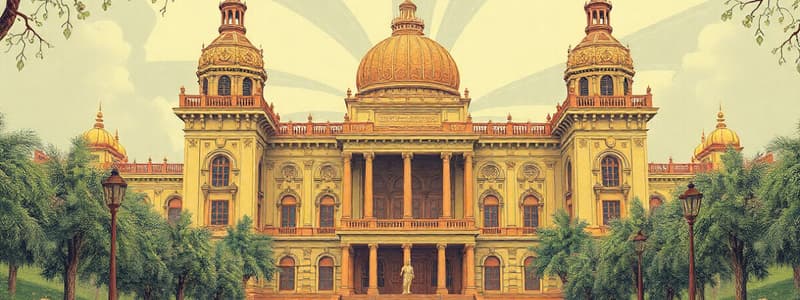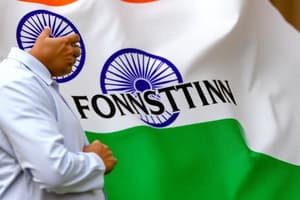Podcast
Questions and Answers
What percentage of the world's population lives in the 25 countries with federal political systems?
What percentage of the world's population lives in the 25 countries with federal political systems?
- 60%
- 25%
- 50%
- 40% (correct)
Which of the following is typically true about large countries regarding political systems?
Which of the following is typically true about large countries regarding political systems?
- Most large countries are federations. (correct)
- Most large countries are unitary states.
- Large countries rarely have complex political systems.
- All large countries have the same political system.
How many countries in the world operate under a federal political system?
How many countries in the world operate under a federal political system?
- 40
- 193
- 50
- 25 (correct)
What is an exception to the rule about large countries typically having a federal system?
What is an exception to the rule about large countries typically having a federal system?
What is the primary geographic distinction made in the content?
What is the primary geographic distinction made in the content?
Which of these options lists only countries known to have federal political systems?
Which of these options lists only countries known to have federal political systems?
What role do federations play in representing the world’s population?
What role do federations play in representing the world’s population?
Which geographical feature is highlighted in discussing the exception of large countries having a federal system?
Which geographical feature is highlighted in discussing the exception of large countries having a federal system?
What does the Union List contain?
What does the Union List contain?
Which statement about the Indian Constitution is correct?
Which statement about the Indian Constitution is correct?
What is a significant challenge faced by countries like Belgium and Sri Lanka in managing diversity?
What is a significant challenge faced by countries like Belgium and Sri Lanka in managing diversity?
Who alone can make laws related to the subjects mentioned in the Union List?
Who alone can make laws related to the subjects mentioned in the Union List?
Why did the Constitution include a three-fold distribution of legislative powers?
Why did the Constitution include a three-fold distribution of legislative powers?
What significant event led to the establishment of a unified constitution for India?
What significant event led to the establishment of a unified constitution for India?
What principle is the Indian Union based on?
What principle is the Indian Union based on?
What issue is related to the management of diversity in large countries like India?
What issue is related to the management of diversity in large countries like India?
What is the main characteristic of the first route of federations?
What is the main characteristic of the first route of federations?
Which of the following countries is NOT listed as an example of the first route of federations?
Which of the following countries is NOT listed as an example of the first route of federations?
What must occur for fundamental provisions of the constitution to be changed?
What must occur for fundamental provisions of the constitution to be changed?
Which of the following best describes the second route of federations?
Which of the following best describes the second route of federations?
In which of the following countries are the powers of different levels of government divided in a 'holding together' federation?
In which of the following countries are the powers of different levels of government divided in a 'holding together' federation?
What role do the courts play in the context of federations?
What role do the courts play in the context of federations?
Which feature is typical of 'coming together' federations?
Which feature is typical of 'coming together' federations?
What signifies the constitutional guarantee of government tiers?
What signifies the constitutional guarantee of government tiers?
What led to the rise of regional political parties during this period?
What led to the rise of regional political parties during this period?
What defines a coalition government?
What defines a coalition government?
What was a major demand from non-Hindi speaking States regarding language use?
What was a major demand from non-Hindi speaking States regarding language use?
Which of the following statements about coalition governments is correct?
Which of the following statements about coalition governments is correct?
What was the response of the Central Government to the demands of the non-Hindi speaking States?
What was the response of the Central Government to the demands of the non-Hindi speaking States?
What kind of challenges might a leader of a coalition government face?
What kind of challenges might a leader of a coalition government face?
What significant event occurred around 1965 regarding language policies?
What significant event occurred around 1965 regarding language policies?
Why did major national parties need to enter into alliances with regional parties?
Why did major national parties need to enter into alliances with regional parties?
Can the Government of Rajasthan prevent the Government of India from conducting nuclear tests?
Can the Government of Rajasthan prevent the Government of India from conducting nuclear tests?
Does the Government of Sikkim need permission from the Union Government to launch new textbooks?
Does the Government of Sikkim need permission from the Union Government to launch new textbooks?
Can the Prime Minister of India enforce a unified policy for state police responses to naxalites?
Can the Prime Minister of India enforce a unified policy for state police responses to naxalites?
What is primarily responsible for the success of federalism in India?
What is primarily responsible for the success of federalism in India?
What has changed in India's political map from 1947 to 2019?
What has changed in India's political map from 1947 to 2019?
What is a necessary factor for the success of federalism?
What is a necessary factor for the success of federalism?
Which of the following statements about state boundaries in India is true?
Which of the following statements about state boundaries in India is true?
What does federalism rely on besides constitutional provisions?
What does federalism rely on besides constitutional provisions?
Flashcards are hidden until you start studying
Study Notes
Federalism in practice
- Though only 25 of the world’s 193 countries have federal political systems, they represent 40% of the global population.
- Most of the large countries in the world are federations, with the exception of China.
- Two routes lead to the formation of a federation:
- Independent states coming together and pooling sovereignty to increase security (e.g., USA, Switzerland, Australia)
- A large country dividing its power between states and a national government (e.g., India, Spain, Belgium)
- The Indian Constitution establishes a three-fold distribution of legislative powers between the Union and State Governments.
- The Union List: Subjects of national importance like defense, foreign affairs, banking, communications, currency. The Union Government has exclusive power to make laws for these subjects.
- The State List: Subjects of regional or local importance like agriculture, education, police, local government. States have the power to make laws on these subjects.
- The Concurrent List: Subjects of common concern like education, forest, trade unions. Both Union and State governments can make laws for these subjects.
- The Indian Constitution has provisions for the creation of new states, changing boundaries and names, and ensuring representation of various regions.
- India experienced a rise of regional political parties and a shift towards coalition governments at the center, where no single party holds a majority in the Lok Sabha.
Cartoons representing the relationship between the center and states
- The first cartoon depicts a state leader going to the center with a begging bowl, representing the need for states to seek funding and support from the central government.
- The second cartoon shows the leader of a coalition government struggling to satisfy all the coalition partners, highlighting the potential challenges in maintaining a cohesive coalition.
Studying That Suits You
Use AI to generate personalized quizzes and flashcards to suit your learning preferences.




